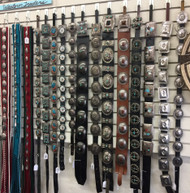Concho Belts - A Native Tradition
Posted by Jim Olson on Mar 3rd 2018
The word concho, sometimes spelled concha, comes from the Spanish word meaning shell. Some of the first “conchos” were made of melted silver dollars and resembled a shell—it is commonly thought this is how the name came about. In Spanish, the correct word is concha, with an a at the end and is pronounced like an ah sound. However, most people now-a-days refer to the Native American style belt as a concho belt, with an o.
Although it is commonly said the Navajo (Dine’) borrowed the idea from Spaniards, the Concho Belt has become a long-standing Native tradition. Concho Belts reportedly began appearing in Navajo country in the late 1860s or early 1870s. Other Native Americans including the Zuni and Hopi also made traditional Concho Belts before long.
The earliest concho belts are now referred to as “First Phase” belts. This style of belt was made before Native silversmiths had learned much about soldering. The conchos were hammered out from melted coins, cut and filed into shape, engraved and a diamond shape slot was cut out of the middle of the concho, with a bar left across the center of the diamond shaped slot for the leather belt to loop through. The first phase conchos required no soldering and is generally thought in terms of the years from the late 1860s to the 1880s.
Next came, you guessed it, the “Second Phase.” In the second phase of concho belt development, the silversmith had began to solder. He now soldered a silver, or later a copper, strap or bar across the back of a concho to run the leather belt through (more often silver in those early years). This allowed for the entire face of the concho to be decorated and kept the leather belt on the backside of the concho. The second phase is generally thought of as being durning the years of the 1890s through early 1900s.
In the last or “Third Phase” of concho belt development, you started to see the “butterfly” appear between conchos and also the use of turquoise as an adornment on the face of a concho. A “butterfly” is simply another smaller concho in between the bigger conchos and its shape somewhat resembles that of a butterfly (a bow shape). Copper for the strap across the back becomes more prevalent than a silver bar as you go further on in time also. A belt with butterflies (and sometimes turquoise) from the early 1900s through the 1930s is generally thought of as “early third phase” and a belt from the 1940s through 70s (or so) would often be referred to as “vintage” while anything newer would be modern to contemporary.
The timelines listed above are general and may differ slightly depending upon who you ask. Natives first had Concho Belts for personal use only, but around the turn of the last century, tourist demand had kicked in and a new outlet for the belts emerged. This is when you started seeing them produced in larger numbers and is also why a belt produced after 1900 is much easier to find than one from the late 1800s.
Today, a fine Concho Belt will be made of sterling silver (or better — .999 silver and gold are also known to be used). They are often embellished with Turquoise (or other gemstones) and are usually mounted on a good leather strap. At times, copper, nickel silver, or silver plated overlay is also used, but these kinds of belts are usually thought of as lower grade and the price should be reflective.
Another form of concho belt which appeared around mid-century was the “link” style concho belt. The link Concho belts are connected by rings between the conchos and fasten with a hook that can be attached at various places on the belt. No leather is used.
Today, thousands of belts are produced annually by Natives and non-Natives alike. Typically, genuine “Native” handmade belts are more sought after by collectors and discerning jewelry buyers. The belts are generally considered unisex and can be worn by both men and women.
Concho Belts can cost into the thousands of dollars depending upon the craftsmanship, amount of silver and rarity of turquoise or gemstones used. A quick google search of concho belts for sale will turn up belts from about $100 to $30,000 or so. Belts at the upper end of that range are usually ones made before the turn of the last century. But as always, a buyer should deal with a reputable dealer as there are many look-a-likes out there. Craftsmanship is hard to fake and a well-made belt deserves a premium, no matter when it was made. However, a well-made belt with some age to it will fetch an even bigger premium—the problem is, age is often faked. So know who you are dealing with when making a purchase.
A genuine concho belt is a treasure which can be handed down from generation to generation. My best advice is to buy as good of quality as you can afford and trade up if you get the chance. Traditionally, quality tends to appreciate (or at least hold) its value better.
Jim Olson © 2018
View our current online inventory of belt buckles and Concho Belts here.

